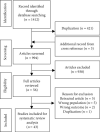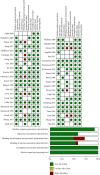Intravenous Fluid of Choice in Major Abdominal Surgery: A Systematic Review
- PMID: 32832150
- PMCID: PMC7421038
- DOI: 10.1155/2020/2170828
Intravenous Fluid of Choice in Major Abdominal Surgery: A Systematic Review
Abstract
Background: Intravenous fluid therapy plays a role in maintaining the hemodynamic status for tissue perfusion and electrolyte hemostasis during surgery. Recent trials in critically ill patients reported serious side effects of some types of fluids. Since the most suitable type of fluid is debatable, a consensus in perioperative patients has not been reached.
Method: We performed a systematic review of randomized control trials (RCTs) that compared two or more types of fluids in major abdominal surgery. The outcomes were related to bleeding, hemodynamic status, length of hospital stay, and complications, such as kidney injury, electrolyte abnormality, major cardiac adverse event, nausea, vomiting, and mortality. A literature search was performed using Medline and EMBASE up to December 2019. The data were pooled to investigate the effect of fluid on macrocirculation and intravascular volume effect.
Results: Forty-three RCTs were included. Eighteen fluids were compared: nine were crystalloids and nine were colloids. The results were categorized into macrocirculation and intravascular volume effect, microcirculation, anti-inflammatory parameters, vascular permeability, renal function (colloids), renal function and electrolytes (crystalloids), coagulation and bleeding, return of bowel function, and postoperative nausea vomiting (PONV). We found that no specific type of fluid led to mortality and every type of colloid was equivalent in volume expansion and did not cause kidney injury. However, hydroxyethyl starch and dextran may lead to increased bleeding. Normal saline can cause kidney injury which can lead to renal replacement therapy, and dextrose fluid can decrease PONV.
Conclusion: In our opinion, it is safe to give a balanced crystalloid as the maintenance fluid and give a colloid, such as HES130/0.4, 4% gelatin, or human albumin, as a volume expander.
Copyright © 2020 Seechad Noonpradej and Osaree Akaraborworn.
Conflict of interest statement
The authors declare that there are no conflicts of interest regarding the publication of this paper.
Figures
Similar articles
-
The impact of crystalloid versus colloid fluids on postoperative nausea and vomiting: A systematic review and meta-analysis of randomized controlled trials.J Clin Anesth. 2020 Jun;62:109695. doi: 10.1016/j.jclinane.2019.109695. Epub 2019 Dec 18. J Clin Anesth. 2020. PMID: 31862216
-
Safety and efficacy of tetrastarches in surgery and trauma: a systematic review and meta-analysis of randomised controlled trials.Br J Anaesth. 2021 Oct;127(4):556-568. doi: 10.1016/j.bja.2021.06.040. Epub 2021 Jul 28. Br J Anaesth. 2021. PMID: 34330414
-
Volume replacement in critically ill patients with acute renal failure.J Am Soc Nephrol. 2001 Feb;12 Suppl 17:S33-9. J Am Soc Nephrol. 2001. PMID: 11251029 Review.
-
Effects of fluid resuscitation with synthetic colloids or crystalloids alone on shock reversal, fluid balance, and patient outcomes in patients with severe sepsis: a prospective sequential analysis.Crit Care Med. 2012 Sep;40(9):2543-51. doi: 10.1097/CCM.0b013e318258fee7. Crit Care Med. 2012. PMID: 22903091
-
Colloid solutions: a clinical update.J Anesth. 2010 Dec;24(6):913-25. doi: 10.1007/s00540-010-1034-y. Epub 2010 Oct 17. J Anesth. 2010. PMID: 20953964 Review.
Cited by
-
Postoperative decrease of albumin (ΔAlb) as early predictor of complications after gastrointestinal surgery: a systematic review.Perioper Med (Lond). 2022 Feb 15;11(1):7. doi: 10.1186/s13741-022-00238-3. Perioper Med (Lond). 2022. PMID: 35164873 Free PMC article. Review.
-
PERIOPERATIVE CARE IN DIGESTIVE SURGERY: THE ERAS AND ACERTO PROTOCOLS - BRAZILIAN COLLEGE OF DIGESTIVE SURGERY POSITION PAPER.Arq Bras Cir Dig. 2024 May 6;37:e1794. doi: 10.1590/0102-672020240001e1794. eCollection 2024. Arq Bras Cir Dig. 2024. PMID: 38716919 Free PMC article.
-
The Effect of Perioperative Fluid Therapy on Postoperative Renal Functions in Patients Receiving Liver Transplantation from Living Donors: A Retrospective Observational Study.Indian J Crit Care Med. 2025 Mar;29(3):251-261. doi: 10.5005/jp-journals-10071-24907. Epub 2025 Feb 28. Indian J Crit Care Med. 2025. PMID: 40110244 Free PMC article.
-
Consensus of the Brazilian association of hematology, hemotherapy and cellular therapy on patient blood management: Intraoperative hemostasis and volume replacement.Hematol Transfus Cell Ther. 2024 Apr;46 Suppl 1(Suppl 1):S32-S39. doi: 10.1016/j.htct.2024.02.015. Epub 2024 Mar 21. Hematol Transfus Cell Ther. 2024. PMID: 38582746 Free PMC article.
-
Anaesthesia for pelvic exenteration surgery.BJA Educ. 2024 Feb;24(2):57-67. doi: 10.1016/j.bjae.2023.11.002. Epub 2023 Dec 22. BJA Educ. 2024. PMID: 38304069 Free PMC article. Review. No abstract available.
References
-
- Awad S., Allison S. P., Lobo D. N. The history of 0.9% saline. Clin Nutrition. 2008;27(2):179–188. - PubMed
Publication types
LinkOut - more resources
Full Text Sources




